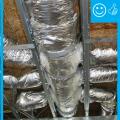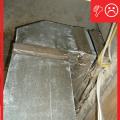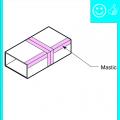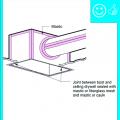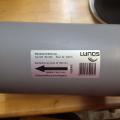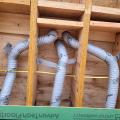Scope
Air-seal and insulate metal ducts.
- Design a compact duct layout with short straight runs and minimal bends. Design the home to include ducts within conditioned space if possible. (The DOE Zero Energy Ready Home program requires that heating/cooling system supply ducts be installed within the conditioned space of the home.)
- Install the metal ducts. Use screws to secure connections. Wipe ducts to ensure they are clean and dry especially at seams and joints.
- Seal all seams and joints in the ducts with mastic. Cover all seams that are wider than 1/8 inch with fiberglass mesh tape then apply mastic.
- Install duct blanket insulation that is covered with a foil or plastic vapor barrier over the ducts. Overlap blanket by 2 inches and staple. Seal insulation blanket seams with mastic or UL-181 metal tape and mastic.
- Insulate all supply and return ducts located in unconditioned space. Meet code or program minimum R-value requirements. See the Compliance tab for R-value minimum requirements specified in the IRC, IECC, DOE Zero Energy Ready Home program, and ENERGY STAR criteria.
- Ensure that all duct connections and seams are air sealed for the following, regardless of whether they are located in conditioned or unconditioned space:
- supply ducts (connections to boots, trunk ducts, other ducts, i.e., duct splicing);
- return ducts (connections to return box);
- ventilation ducting (connections to exhaust fans, for ERV/HRV dedicated ducts)
- pressure balancing (connections for jump ducts, dedicated returns).
- Ensure that insulation completely covers ducts and connections without gaps, voids, or compressions.
- Consider insulating all metal ductwork located in conditioned space, including supply and return ducts, duct boots, and exhaust ducts, to minimize condensation.
See the Compliance Tab for links to related codes and standards and voluntary federal energy-efficiency program requirements.
Description
Ideally ducts should be located in conditioned space, such as within a dropped ceiling, between floors, in an insulated basement or crawlspace, or in an unvented attic that is insulated along the roof line. If ducts are located in an unconditioned space, such as a vented attic or vented crawlspace, they should be sealed and insulated to prevent heat loss due to air leaks and conduction and to provide some protection against harsh conditions.
Sealing
Duct leakage is a double hit on the utility bill: 1) duct leaks are an uncontrolled loss of conditioned air to the outdoors and 2) duct leakage drives building infiltration. For example, if a home had a 2.5-ton (30,000 BTU/H) cooling system moving 1,000 CFM (cubic feet per minute) of air and the ducts had 10% leakage (which is typical in code-built homes), the leakage rate would be 100 CFM. Each cubic foot of air carries with it 30 BTUs/H, so 3,000 BTUs of conditioned air would be lost to the outdoors each hour.
Duct leakage is an infiltration driver; it can negatively or positively pressurize the house depending on where the ducts are leaking, pulling outside air in through cracks in the building envelope or pushing conditioned air out. If the duct leakage is in the supply-side ducts, the house will be negatively pressurized compared to outdoors. If all the leakage is on the return side, the building will be positive with respect to outdoors. The field technician should understand this concept to help accurately diagnose the dominant sources of duct leakage.
Insulation
Whenever ductwork is located in unconditioned spaces, thermal insulation with a vapor barrier is a must to prevent unnecessary heat gain or loss through the duct walls and to prevent condensation from forming on the ducts themselves. For the insulation to work properly, it must be fully aligned and in contact with the walls of the duct system. A typical vented attic with a dark shingle roof can reach summer temperatures of 140ºF. At the same time, the dew point temperature in the attic will be about the same as it is outdoors. In humid climates "duct sweating" can become a significant problem if the ducts’ thermal and vapor barriers are not properly aligned along the entire length of the ducts.
Metal ductwork is constructed using sheets of galvanized steel. Metal ducts are either rectangular or round in shape. Metal ducting consists of straight lengths, elbows, connectors, junction boxes, and register boots that are purchased or fabricated in the HVAC contractor’s shop and fitted together at the job site. A compact duct layout design with short, straight runs and minimal bends provides the best performance from an air flow standpoint and also reduces the number of lengths and seams that need to be sealed and insulated.
For more on duct layout, see No Kinks or Sharp Bends in Flex Duct Installation.
Duct installation standards and installation guidance are also provided in Manual D Residential Duct Systems 2009 Edition published by the Air Conditioning Contractors of America.
Metal ducts for residential HVAC systems are typically insulated on the exterior using a "duct wrap," such as fiberglass blanket insulation with a foil-faced vapor barrier. Duct wrap comes in four-foot-wide rolls 50 to 100 feet long and in R-values that range from R-4 through R-8. Before applying duct wrap, sheet metal duct should be clean, dry, and tightly sealed at all joints and seams. The 2009 IECC (Section 403.2) requires that supply ducts located in unconditioned space be insulated to at least R-8 (return ducts can be insulated to R-6).
Ducts should be sealed with duct mastic and/or metal tape that meets the requirements of the Underwriters Laboratory UL-181, UL-181A, or 181B (CEC 2005). Regular cloth-backed duct tape should not be used because it can dry out and fail quickly. Mastic is a thick, gooey, non-hardening substance that is spread onto the duct seams with a paintbrush or a putty knife. For additional strength with seams that are wider than 1/8 inch, cover the gap with fiberglass mesh tape then apply the mastic.
How to Seal and Insulate Metal Duct
- Install the metal ducts. Fit pieces together at joints by sliding the wider pipe over the narrower connecting collars. Use screws to secure connections. Wipe ducts with a dry cloth to ensure they are clean and dry especially at all joints and seams.
Use mastic to seal the seams along the lengths of the pipes, the seams in the elbows, the joints where the elbow and straight pieces are joined, where ducting is joined to the air handler, junctions between trunk ducts and branch ducts, and at duct boots.

Figure 1. Seal all joints and seams in the metal ductwork with mastic, including all joints and seams in elbows, before installing insulation. - Measure foil-faced blanket insulation to fit around the circumference of the pipe with two inches of overlap. Wrap the insulation around the duct with the facing to the outside so the 2-inch flap completely overlaps the facing and insulation at the other edge of the insulation. Insulation should be snugly butted but not wrapped too tightly, which would compress the insulation and reduce its R value. Follow the manufacturer’s "stretch-out" guidelines, which specify how much insulation to use, based on the pipe circumference, to ensure that the insulation thickness is maintained to achieve the rated R-value (see Table 1). The insulation should be a minimum of R-8 for all supply ducts and at least R-6 for all return ducts.
| Labeled Thickness (in.) | Installed Compressed Thickness (in.) | Round | Square | Rectangular |
|---|---|---|---|---|
| 1.0 | 0.75 | P + 7.0" | P + 6.0" | P + 5.0" |
| 1.5 | 1.125 | P + 9.5" | P + 8.0" | P + 7.0" |
| 2.0 | 1.5 | P + 12.0" | P + 10.0" | P + 8.0" |
| 2.3 | 1.75 | P + 13.0" | P + 11.0" | P + 8.5" |
| 2.0 | 2.25 | P + 17.0" | P + 14.5" | P + 11.5" |
Stretch-outs include 2 inches (51 mm) for overlap. P = Perimeter of duct to be insulated | ||||
- Overlap the insulation and staple along the seam every 6 inches at the "tape flap" using outward-clinching staples.
- Wrap another piece of insulation around the next section of duct, overlapping two inches at the end of the first piece of insulation. Staple along the lengthwise seam and at the overlap. Continue overlapping and stapling until the entire length of duct is covered. After stapling, cover and seal all tape flaps and overlaps with UL-181 metal tape or mastic (mastic is recommended).
- Make sure insulation covers all pipe connections to trunk duct, junction boxes, and boots.

Success
After ducts are installed and before drywall is installed, the duct system should be visually inspected by a HERS rater to ensure that all connections are properly fastened and sealed, preferably with mastic. Locations to inspect include the main supply trunk to branch connections, at the duct boots, duct splices, the return box to the return ducts, jump duct connections, and exhaust fan and ERV/HRV connections. HVAC ducts should be tested for air leakage and proper air flow with a duct blaster test. This test should be done before drywalling when any air leaks can still be accessed and sealed. Ducts should be insulated along the length including at connections and the insulation should not be compressed by tight strapping, by framing members, or by excessive bending. The insulation should be a minimum of R-8 for all supply ducts and at least R-6 for all return ducts.
Climate
No climate specific information applies.
Training
Compliance
Retrofit
SCOPE
Additions
If new metal duct is added to an existing home, either as part of an addition or an equipment upgrade, ensure that the metal duct is installed in runs that are as short, straight, and direct as possible, and that they are well air sealed and insulated, as described in the Description tab.
Existing Buildings
In an existing building with metal duct and an under-performing HVAC system, inspect for lack of air sealing and adequate insulation. Symptoms may include poor comfort control and excessive energy use.
For more information, view the U.S. Department of Energy’s Standard Work Specifications regarding ducts.
If the ducts are located in the attic, review the guide Pre-Retrofit Site Assessment of Attics, Ceilings and Roofs.
If the ducts are located in the basement or crawlspace, review the guide Pre-Retrofit Site Assessment of Crawlspaces and Basements.
DESCRIPTION
Uninsulated (or under-insulated) ducts waste heating and cooling energy when the ducts are located in unconditioned space. In humid climates, they can also become a source of moisture damage. When warm, humid air comes in contact with the cold surface of a duct delivering chilled air the water vapor can condense to liquid water that can cause rust in the ducts and mold in insulation, framing, and other building materials.
Air sealing and insulating is even important for ducts in conditioned space as these measures can help ensure hot or cold air reaches its destination.
For the installation of sheet metal ducts in retrofit and existing building situations, follow all best practices and precautions in the Description tab for new construction. Poor comfort control and wasted energy occur when conditioned air doesn’t make it all the way to the target space (due to leakage in the system) or when the target temperature of the conditioned air is compromised (due to heat gain or loss through uninsulated or under-insulated ductwork.) Additionally, duct leakage can drive infiltration, increasing the entrance of uncontrolled outdoor air that requires conditioning.
Note that the physical connections of all ducts must be properly sealed before the addition of insulation, and then the insulation material and jacketing must also be sealed. See Duct Sealing for detailed sealing guidance.
Additions
Coordinate the duct layout for a new space with the design of the structure and other systems to ensure there is space for proper routing. As with new construction, use ACCA Manual D and provide a drawing of the layout to the homeowner for future reference.
Existing Buildings
See Pre-Retrofit Assessment of Existing HVAC Systems for a discussion of how to determine whether a flawed duct design may be contributing to poor HVAC system performance.
ENSURING SUCCESS
When re-routing ductwork, access the ducts directly from the basement, crawlspace, or attic if possible. If the ducts are behind finish materials like drywall, it is tempting to make the smallest possible openings in existing ceilings and walls in an effort to reduce disruption. It will be impossible to fully examine the entire duct layout if openings are too small. Instead, cut openings in drywall large enough to fit head and shoulders so that the duct can be manipulated into the best possible orientation.
Although an existing duct system is generally not required to be brought up to code when making repairs (double check this with the local code official), you can take this opportunity to check the ducts for duct leakage and seal all accessible seams and joints; use outward-clinched staples and UL-181A-approved metal tape that is heat activated or pressure sensitive or use mastic and fiber mesh tape. You can also add duct insulation where it is lacking or deficient, especially if you see evidence that condensation has been occurring.
Starting with the 2009 International Energy Conservation Code (IECC), supply ducts located in unconditioned space must be insulated to at least R-8, and return ducts must be insulated to R-6.
COMPLIANCE
See Compliance tab.
More
More Info.
Access to some references may require purchase from the publisher. While we continually update our database, links may have changed since posting. Please contact our webmaster if you find broken links.
The following authors and organizations contributed to the content in this Guide.
Sales
High-R Duct Insulation =

Without adequate duct insulation, there can be significant heat loss or heat gain as conditioned air travels through the comfort delivery system. This is especially true where ducts are located in an uninsulated attic or crawlspace. Insulation significantly reduces this energy loss and helps ensure conditioned air is effectively distributed from the comfort equipment to a home’s living spaces.


